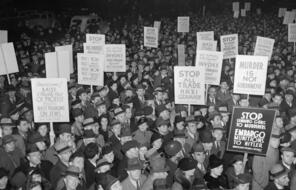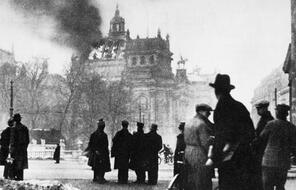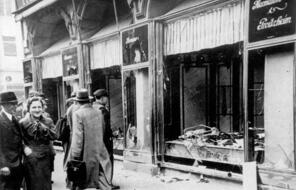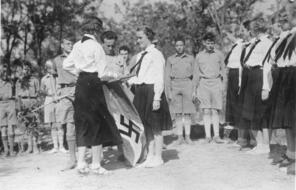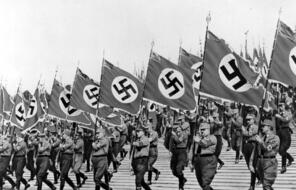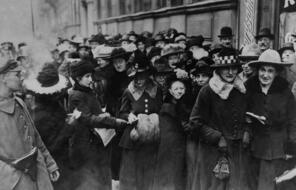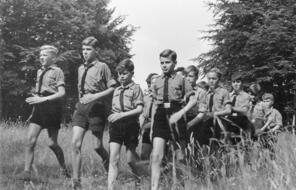"The Battle for Work"
Subject
- History
Language
English — USUpdated
The Nazi Party’s popularity increased in the early 1930s partly because of its pledge to do what no other political party had been able to accomplish: pull Germany out of the Great Depression and put Germans back to work. In his first radio address as chancellor, Hitler promised to overcome unemployment in Germany within four years. This would be no small task. From mid-1929 to January 1933, the number of Germans who had full-time jobs fell from 20 million to 11.5 million; by the start of 1933, at least 6 million Germans were unemployed. 1 Could Hitler make good on his promise?
According to historian Richard Evans, “Hitler’s government was lucky in its timing,” because a variety of economic programs begun under previous chancellors were finally starting to put more Germans back to work by the time of Hitler’s appointment. 2 In addition, the Nazis manipulated the official statistics about unemployment in order to convince the public of their progress. 3
Hitler’s government also put in place several new plans that would put Germans back to work. In 1933, the government announced two Laws for the Reduction of Unemployment, devoting millions of marks to encouraging the creation of new businesses and funding public-works construction projects, such as the highway system. Another policy encouraged working women to leave their jobs and stay home, lessening competition for jobs and improving unemployment statistics (see reading, Breeding the New German "Race"). The Nazis also encouraged, and often coerced, unemployed workers to join the nation’s Volunteer Labor Service, where they were put to work on public land and construction projects.
But, as Evans explains, the Nazi job creation program was about more than economic recovery; it focused on rebuilding and rearming the nation’s military arsenal. By explaining rearmament as “job creation,” the Nazis attempted to conceal this violation of the Treaty of Versailles:
In 1933 Germany was more or less without an air force, without capital ships, without tanks, without the most basic items of military equipment, and restricted to an army of no more than 100,000 men. Already in February 1933 Hitler set a programme of rearmament in motion, where possible disguised as job creation . . .
The army drew up a register of 2,800 firms to which arms orders could be sent; in 1934 these accounted for over half of all iron and steel, engineering and motor vehicle inspection. . . . By 1935 there were 72,000 workers employed in aircraft construction, compared to fewer than 4,000 at the beginning of 1933. Similarly, Krupps embarked on the large-scale production of what were coyly described as “agricultural tractors” in July 1933; in reality they were tanks. In 1934, the Auto Union company launched another military vehicle production department. . . . In November 1933 the navy ordered over 41 million Reichsmarks’ worth of military equipment and another 70 million Reichsmarks’ worth of ships. Major firms such as Borsig, in Berlin, and the Bochumer Association, in Hanover, started up production of rifles and guns. All this had an immediate effect on employment. Already in January 1933 the Mauser rifle factory increased its workforce from 800 to 1,300; in the first four months of 1933, the Rhine Metal Company, which made howitzers and machine guns, took on 500 new workers too. Similar developments could be observed in hundreds of companies across Germany. All this feverish activity inevitably had a knock-on [secondary] effect on industry more broadly, as iron and steel, engineering, coal and mining companies stepped up production and hired additional labour to cope with the new and rapidly rising demand from the arms and arms-related sector. 4
By the end of 1934, the government was touting its own statistics that claimed that the unemployment level was less than half of what it had been when Hitler was appointed chancellor. While rearmament certainly did create thousands of jobs, it also advanced the Nazis’ longer-term goal to re-establish Germany as a European military power. All in all, the program helped to increase public support for the Nazis, as Evans explains:
Hitler’s boast that he would solve the unemployment problem within four years of taking office seemed to have been triumphantly justified. Incessant Nazi propaganda boasting that the “battle for work” was being won gained widespread credence. It helped win over many doubters and sceptics to the government’s side from May 1933 onwards, and pumped new euphoria into the Third Reich’s supporters. 5
Connection Questions
- Why do you think Hitler focused on unemployment in the beginning of his time as chancellor? What factors do you think helped make the economy a priority? Base your answer on evidence from both this reading and previous ones.
- Summarize the strategies Hitler used to improve employment in Germany. Which actions seem most justified, given the hardship caused by the Great Depression? Which actions are most troubling?
- How might difficult economic times affect a person’s universe of obligation? How might a bad economy affect a person’s priorities when deciding which political leaders and parties to support?
- Why do you think the Nazi “battle for work” might have convinced some who previously opposed the Nazis to change their minds?
- 1Richard J. Evans, The Third Reich in Power (New York: Penguin, 2005), 328.
- 2Richard J. Evans, The Third Reich in Power (New York: Penguin, 2005), 329.
- 3Richard J. Evans, The Third Reich in Power (New York: Penguin, 2005), 334–35.
- 4Richard J. Evans, The Third Reich in Power (New York: Penguin, 2005), 338–41. Reproduced by permission from Penguin Press.
- 5Richard J. Evans, The Third Reich in Power (New York: Penguin, 2005), 333. Reproduced by permission from Penguin Press.
How to Cite This Reading
Facing History & Ourselves, “"The Battle for Work"”, last updated August 2, 2016.

